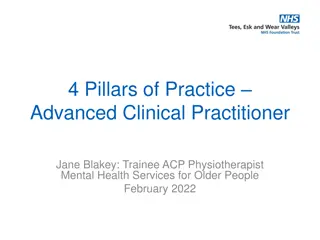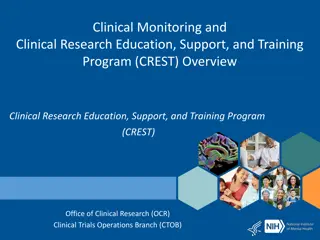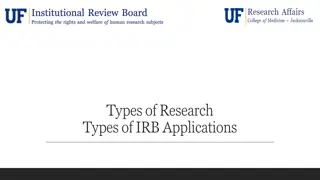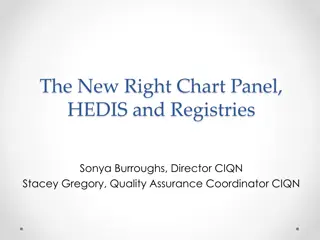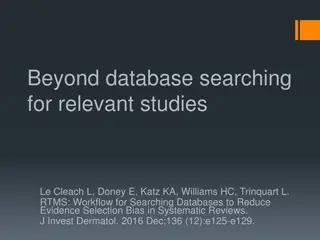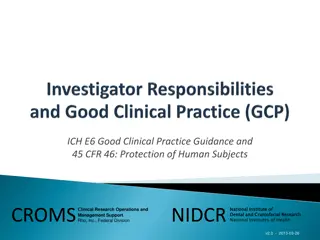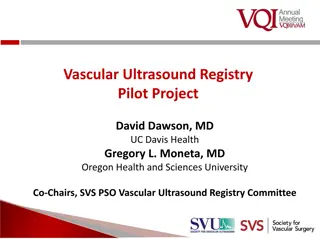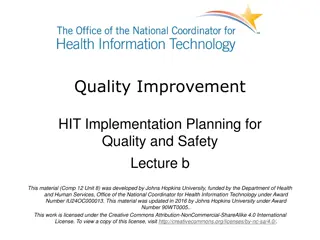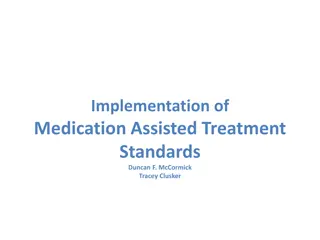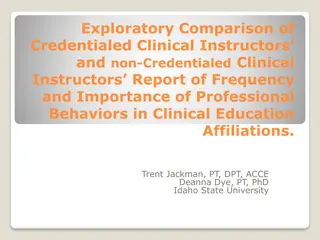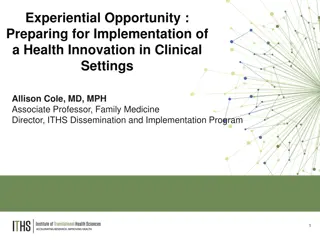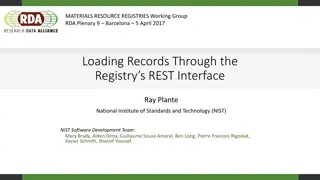Clinical Registries: Key Concepts and Implementation Strategies
Clinical registries play a crucial role in tracking real-world data and outcomes for various medical conditions. They are observational databases that collect data systematically for specific purposes. Distinct from clinical trials, registries provide insights into broader patient populations and real-world practices. Setting up a registry involves defining its purpose, identifying stakeholders, ensuring feasibility, securing funding, and establishing governance. Various stakeholders, including physicians, patient advocacy groups, and payers, benefit from registry data. Several current registries focus on congenital heart diseases and critical cardiac care.
Download Presentation

Please find below an Image/Link to download the presentation.
The content on the website is provided AS IS for your information and personal use only. It may not be sold, licensed, or shared on other websites without obtaining consent from the author. Download presentation by click this link. If you encounter any issues during the download, it is possible that the publisher has removed the file from their server.
E N D
Presentation Transcript
SCAI 2020 Date: May 14, 2020 Symposium: Learning From the Past Help From Registry Data: How Are They Set Up? Daisuke Kobayashi, MD, MPH, FSCAI Division of Cardiology, Children s Hospital of Michigan Clinical Associate Professor of Pediatrics, Central Michigan University College of Medicine
Disclosures No conflict of interest
What is Registry? A clinical registry is an observational database focused on a clinical condition, procedure, therapy, or population. Data are collected systematically for specific scientific, clinical or policy purposes. Bhatt DL, et al. ACC/AHA/STS Statement on the Future of Registries and the Performance Measurement Enterprise. J Am Coll Cardiol.2015 Nov 17;66(20):2230-2245.
Clinical Trials vs. Registries Clinical Trials Registries Controlled experiments designed to test hypotheses Strict constraints with detailed inclusion and exclusion criteria Limited generalizability Cost: $$$$ Observe real-world clinical practice More representative of real-world practice Generalizable to a wide range of patients Cost: $-$$$
How to set up a registry General Key Steps 1. Articulate its purpose 2. Determine whether it is an appropriate means of addressing the research question 3. Identify stakeholders 4. Define the scope and target population 5. Assess feasibility 6. Secure funding 7. Plan registry governance and oversight Gliklich RE, et al. Registries for Evaluating Patient Outcomes: A User's Guide [Internet]. 3rd edition. Rockville (MD): Agency for Healthcare Research and Quality (US); 2014 Apr. Section I, Creating Registries.
Values of Registries for Different Stakeholders Physicians Real World Data From Registries Physician Organizations Patient and Advocacy Organizations Payers Industries Gliklich RE, et al. Registries for Evaluating Patient Outcomes: A User's Guide [Internet]. 3rd edition. Rockville (MD): Agency for Healthcare Research and Quality (US); 2014 Apr. Section I, Creating Registries.
Current Registries in congenital heart disease Surgery STS CHSD: Society of Thoracic Surgeons Congenital Heart Surgery Database Single Ventricle Patients NPC-QIC: National Pediatric Cardiology Quality Improvement Collaborative Cardiac ICU PC4: Pediatric Cardiac Critical Care Consortium Cardiomyopathy PCMR: Pediatric Cardiomyopathy Registries Catheterization IMPACT: Improving Pediatric and Adult Congenital Treatments C3PO: Congenital Cardiac Catheterization Project on Outcomes CCISC: Congenital Cardiovascular Interventional Study Consortium
CCISC Set Up (Congenital Cardiovascular Interventional Study Consortium) CCISC is a non-for-profit organization dedicated to the advancement of the science and treatment of congenital heart disease. Mission: to design, conduct and report the findings of scientific studies in interventional cardiovascular care for individuals with congenital heart disease. Major Projects CCISC Listserv CoA registry Risk registry CAF registry Bivalirudin Study CCISC Coordinators - Thomas Forbes - Nancy Sullivan Data Management Center (Wayne State University) National Investigators
Future of CCISC Registry Registry as Real-World Data
Real-World Data (RWD) FDA Regulatory Decisions on Post-approval Device Study Real-World Evidence (RWE)
Meet the Standards of FDA Regulatory Process Pre-submission process Reliability of RWD - Data accrual - Data assurance
Need the Platform for the Registries as RWD Investigators Industries FDA Platform (CCISC-FDA Modules) Time, Cost, Resource utilization
Similarity of Study Design and Data Variables between clinical trials ASD Trials - Amplatzer Septal Occluder - Gore Helex - Gore Cardioform Septal Occluder - Gore Cardioform ASD Occluder TPVI Trials - Medtronic Melody valve - Edwards Sapien XT - Edwards Sapien 3 PDA Trials - ADO I - ADO II - Nit-Occlude PDA coil - ADO II AS Inclusion /exclusion criteria Primary / secondary endpoints Demographic data Cath data Pre and post-cath echo data Follow up data
CCISC-FDA Module Platform Standardization of database development - Through the single qualified data management center Standardization of Protocol development - Through collaboration between the FDA, industries, and investigators Streamline IRB Process Standardization of DUA / Contract process - Working with industries for a common template for all modules
CCISC-FDA Modules Pulmonary artery stent Pulmonary valve stent ASD pm VSD CoA PDA Modules Device 1 Device 2 PASS Pulmonary Artery Stent Study Track
CONCLUSION - Help from Registry Data Registries can form RWD and make RWE. Setting up of registries may be pursued through the new platform of CCISC-FDA modules. To be considered as RWD by the FDA, registries need to meet the FDA regulatory standards. To SET UP the future registries, pre-submission process and discussion with FDA is one of the key steps. Reduction of time and cost may be achieved through the CCISC- FDA platform.
Questions? Daisuke Kobayashi, MD, MPH, FSCAI Children s Hospital of Michigan dkobayas@dmc.org





